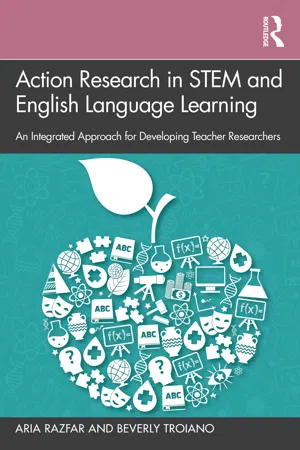
Action Research in STEM and English Language Learning
An Integrated Approach for Developing Teacher Researchers
Aria Razfar, Beverly Troiano
- 160 pages
- English
- ePUB (mobile friendly)
- Available on iOS & Android
Action Research in STEM and English Language Learning
An Integrated Approach for Developing Teacher Researchers
Aria Razfar, Beverly Troiano
About This Book
Responding to the linguistic and cultural diversity of the U.S. K–12 student population and an increasing emphasis on STEM, this book offers a model for professional development that engages teachers in transformative action research projects and explicitly links literacy to mathematics and science curriculum through sociocultural principles. Providing detailed and meaningful demonstrations of participatory action research in the classroom, Razfar and Troiano present an effective, systemic approach that helps preservice teachers support students' funds of knowledge. By featuring teacher and researcher narratives, this book centers teacher expertise and offers a more holistic and humanistic understanding of authentic and empathetic teaching. Focusing on integrating instructional knowledge from ESL, bilingual, and STEM education, the range of cases and examples will allow readers to implement action research projects in their own classrooms. Chapters include discussion questions and additional resources for students, researchers, and educators.
Frequently asked questions
Information
1 Integrating Language Learning and STEM through Action Research
We found that teacher collaboration strengthens our abilities as educators. While we initially found ourselves struggling to connect students’ playground funds to the FOSS [mandated] curriculum, Ms. Abby’s science expertise, Ms. Karen’s knowledge of standards and curriculum planning, and Ms. Lorena’s prominence in the community and Spanish language expertise helped us design transformative science curriculum through linguistic and science funds.Karen, First-Grade Teacher, Genesis Elementary [Chapter 2]
I’m more confident in this way of teaching because it’s better for my students. This year I feel like especially with all the changes in middle school [science curriculum] that I am doing what is best for my students and I have proof that inclusion is the best for my students and I think a lot of stuff that we did last year has empowered me to say I am doing what is best for my students. I don’t care what your book says I am doing what is best for them.Dana, Fifth-Grade Special Education [Chapter 3]
Despite the fact that I valued other cultures and languages and had traveled and lived extensively overseas, I did not know how to value students’ home language in my classroom. When I first began encouraging them to use Spanish in the classroom, they were pleasantly surprised. By the end of the year, many comfortably wrote and spoke in Spanish.Susan, Seventh- and Eighth-Grade Language Arts Teacher [Chapter 4]
Language development is so important for English learners … that’s what this action research project pointed out to me. Also, that science is there for them to develop their language and vocabulary.Allison, Eighth-Grade Science Teacher [Chapter 5]
I came to change during the action research project, realizing how important it was to allow students to use their native language to clarify or communicate with classmates. During the beginning of the year, this change began, but ultimately once the project began. I would consistently use Spanish when I could to clarify and to encourage the EL students to speak. I also tried to encourage my African-American students to use African American Vernacular English.Cara, Second-Grade Teacher [Chapter 6]
Introduction
Table of contents
- Cover Page
- Half Title page
- Title Page
- Copyright Page
- Contents
- Acknowledgments
- Authors
- Contributors
- Foreword
- 1 Integrating Language Learning and STEM through Action Research
- 2 Teaching Math and Science Through Playground Activism
- 3 Community Renewable Energy Designing Solar Panels Through Science-Funds of Knowledge
- 4 Preparing the Next Generation of City Planners and Tech-Savvy Teachers
- 5 From IRE to Conversational Shifting Classroom Discourse Through Community-Based Forensics Expertise
- 6 From Weslandia to Urban Gardening Shifting Teacher Language Ideologies Through Ecological Science and Third Space
- 7 Sustaining Teaching Excellence and Professional Identity Across Time and Space From Reporting to Sharing
- 8 Breaking the Fourth Wall Rebuilding University and School Partnerships Through Action Research
- Epilogue
- Appendix A Activity Triangle Template
- Appendix B Fund of Knowledge Inventory Table
- Appendix C Social Organization of Learning Protocol (Adapted from Razfar)
- Appendix D Field-Note Observation Template
- Appendix E Coding Sheet Template
- Appendix F Discourse Analysis Transcription Conventions
- Appendix G Unit Planning
- Appendix H Final Reporting Tools
- Index